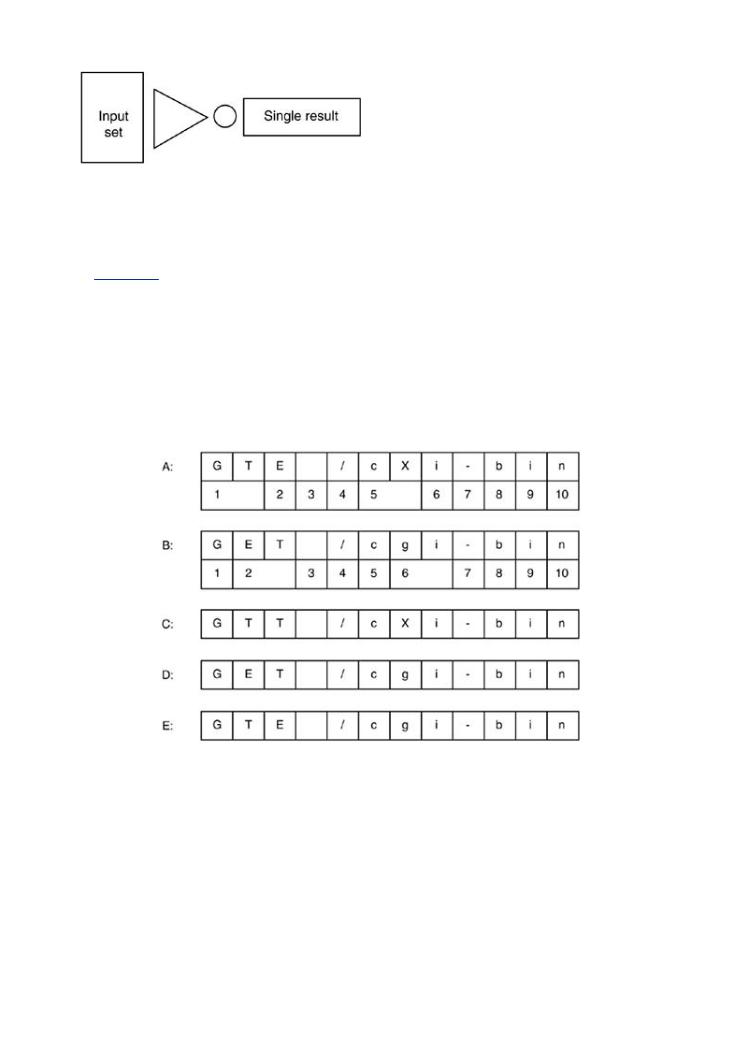
- •Exploiting Software How to Break Code
- •Table of Contents
- •Copyright
- •Praise for Exploiting Software
- •Attack Patterns
- •Foreword
- •Preface
- •What This Book Is About
- •How to Use This Book
- •But Isn't This Too Dangerous?
- •Acknowledgments
- •Greg's Acknowledgments
- •Gary's Acknowledgments
- •Bad Software Is Ubiquitous
- •The Trinity of Trouble
- •The Future of Software
- •What Is Software Security?
- •Conclusion
- •Chapter 2. Attack Patterns
- •A Taxonomy
- •An Open-Systems View
- •Tour of an Exploit
- •Attack Patterns: Blueprints for Disaster
- •An Example Exploit: Microsoft's Broken C++ Compiler
- •Applying Attack Patterns
- •Attack Pattern Boxes
- •Conclusion
- •Into the House of Logic
- •Should Reverse Engineering Be Illegal?
- •Reverse Engineering Tools and Concepts
- •Approaches to Reverse Engineering
- •Methods of the Reverser
- •Writing Interactive Disassembler (IDA) Plugins
- •Decompiling and Disassembling Software
- •Decompilation in Practice: Reversing helpctr.exe
- •Automatic, Bulk Auditing for Vulnerabilities
- •Writing Your Own Cracking Tools
- •Building a Basic Code Coverage Tool
- •Conclusion
- •Chapter 4. Exploiting Server Software
- •The Trusted Input Problem
- •The Privilege Escalation Problem
- •Finding Injection Points
- •Input Path Tracing
- •Exploiting Trust through Configuration
- •Specific Techniques and Attacks for Server Software
- •Conclusion
- •Chapter 5. Exploiting Client Software
- •Client-side Programs as Attack Targets
- •In-band Signals
- •Cross-site Scripting (XSS)
- •Client Scripts and Malicious Code
- •Content-Based Attacks
- •Conclusion
- •Chapter 6. Crafting (Malicious) Input
- •The Defender's Dilemma
- •Intrusion Detection (Not)
- •Partition Analysis
- •Tracing Code
- •Reversing Parser Code
- •Misclassification
- •Audit Poisoning
- •Conclusion
- •Chapter 7. Buffer Overflow
- •Buffer Overflow 101
- •Injection Vectors: Input Rides Again
- •Buffer Overflows and Embedded Systems
- •Database Buffer Overflows
- •Buffer Overflows and Java?!
- •Content-Based Buffer Overflow
- •Audit Truncation and Filters with Buffer Overflow
- •Causing Overflow with Environment Variables
- •The Multiple Operation Problem
- •Finding Potential Buffer Overflows
- •Stack Overflow
- •Arithmetic Errors in Memory Management
- •Format String Vulnerabilities
- •Heap Overflows
- •Buffer Overflows and C++
- •Payloads
- •Payloads on RISC Architectures
- •Multiplatform Payloads
- •Prolog/Epilog Code to Protect Functions
- •Conclusion
- •Chapter 8. Rootkits
- •Subversive Programs
- •A Simple Windows XP Kernel Rootkit
- •Call Hooking
- •Trojan Executable Redirection
- •Hiding Files and Directories
- •Patching Binary Code
- •The Hardware Virus
- •Low-Level Disk Access
- •Adding Network Support to a Driver
- •Interrupts
- •Key Logging
- •Advanced Rootkit Topics
- •Conclusion
- •References
- •Index

Intrusion Detection (Not)
One particularly clever way to craft input is to change the way a request looks as it traverses over the network. This can be accomplished easily by adding extra characters or replacing certain characters with other characters (or representations of characters). This simple kind
• |
Table of Contents |
of input crafting takes place all the time. Attackers who want to evade a simplistic IDS (and |
|
• |
Index |
most of them these days remain simplistic) obfuscate an attack by using alternative character |
|
Expl it |
Software How to Break Code |
encoding and other related techniques. IDS evasion provides a classic example of using
crafted input to your favor. Of course, crafted input can be used in many other ways to evade
ByGreg Hoglund,Gary McGraw
filters and/or cause logic errors.
Publisher: Addison Wesley
Pub Date: February 17, 2004
Signature-Based versus Anomaly-Based IDSs
ISBN: 0-201-78695-8
Pages: 512
At their heart, IDSs are supposed to be conceptually similar to burglar alarms. The burglar breaks in, the alarm sounds, the authorities show up. This is reactive security at its apex. Businesses like Counterpane (a managed security service) exist to monitor IDS frameworks and deal with attacks.
How does software break? How do attackers make software break on purpose? Why are There are two basic philosophies commonly found in IDS technology today—signature-based
firewalls, intrusion detection systems, and antivirus software not keeping out the bad guys? approaches and anomaly-based approaches. On one hand, signature-based technology relies
What tools can be used to break software? This book provides the answers.
on a database of known attack specifics. The idea is to compare traffic or logs, or some other
input, with a list of bad things and to flag problems. So, in essence, signature-based Exploiting Softwareis loaded with examples of real attacks, attack patterns, tools, and
technology detects known bad things. On the other hand, anomaly-based technology relies techniques used by bad guys to break software. If you want to protect your software from
on learning what normal system behavior looks like and then detecting anything that doesn't attack, you must first learn how real attacks are really carried out.
fit the model. Anomaly-based technology detects "not good" things, where "good" is defined
by the model. The approaches are fundamentally different.
This must-have book may shock you—and it will certainly educate you.Getting beyond the
script kiddie treatment found in many hacking books, you will learn about
A signature-based IDS must know explicitly about an exploit or an attack before it can be
detected. Because of this, signature-based systems are easy to avoid, and savvy attackers
skate by the IDS, do a little twirl in the air, and keep on going. If you know what features are Why software exploit will continue to be a serious problem
used to set off alarms, you can avoid them. One thing that makes avoiding these systems
particularlyWhen networkeasy is thsecurifactythatmechanismsmost signaturedo not-basedwork IDSs must know precisely what an
attack looks like or else they simply don't detect anything. That's why simple tweaks to the
inputAstreamtack patternswork so well for IDS avoidance.
An anomalyReverse-basedengineeringIDS doesn't really care what a specific attack looks like. Instead, it learns
anomalyReverse-basedengineeringIDS doesn't really care what a specific attack looks like. Instead, it learns
what normal patterns look like and then proceeds to find nonnormal patterns (anomalies).
Classic attacks against server software
Anything that doesn't look normal enough gets flagged. The problem is (of course) that
normal users don't always act and look the same. Thus, in practice, anomaly-based systems
Surprising attacks against client software
have a hard time separating novel but good from novel but not good. Clever attacks against
anomaly-based systems using statistical windows are possible. One technique is to move the
 Techniques for crafting malicious input
Techniques for crafting malicious input
statistical profile from "completely normal" behavior very slowly into "attack space" in such a
way that the model chugs merrily along, marking all behavior (including, ultimately, the  The technical details of buffer overflows
The technical details of buffer overflows
attack) as normal.[3]
 Rootkits
Rootkits
[3] This clever attack was first described by Teresa Lunt in a paper about the early intrusion detection
system called NIDES. For more information, go to
Exploiting Softwareis filled with the tools, concepts, and knowledge necessary to break http://www.sdl.sri.com/programs/intrusion/history.html.
software.
In the final analysis, a signature-based system can't catch anyone who is using the latest (presumably novel) attacks, and an anomaly-based system falls prey to the "cry wolf" phenomenon, and keeps catching normal users who are just trying to get their work done. Because impeding real work tends to get people fired and security systems thrown away, anomaly-based systems are almost never used in practice. And because people tend to forget about things they cannot see, feel, or taste, signature-based IDSs are fairly widely adopted despite their shortcomings.

Of course all IDSs can be used to create a diversion. One very common attack technique is to cause an IDS to "go ballistic" in one area of the network, while actually carrying out a clever attack elsewhere. Another common technique is to force an IDS to fire so often and with such regularity that it is eventually turned off in frustration. Then the real attack begins. Suffice it to say, many IDSs are not worth the money they cost, especially if the operating costs are factored in.[4]
• |
[4] This point of view has been repeated by the Gartner analyst group in an often-cited report. Go to |
Table of Contents |
|
|
http://www.csoonline.com/analyst/report1660.html for an overview. |
•Index
Exploiting Software How to Break Code
IDSsByGreg Hoglundas a ,ReactiveGary M Graw Subscription Service
RecallPublisthater: almostAddison Wesleyall remote exploits against software rely on some sort of malformed transactionPub Date: Februaryover the17,network2004 . An attack transaction is usually unique in some way. IDSs bank on thisISBN:concept0-201.-In78695fact,-8 this is precisely what allows network IDSs to work at all. In practice,
a network IDS is usually a network sniffer (think Snort) with a large set of trigger filters
Pages: 512
representing known attacks. The technology used in modern systems is, for the most part, no different than sniffer technology from 20 years ago. When put into action, trigger filters match various network packets that are thought to be malicious. These trigger filters are calledattack signatures.
How does software break? How do attackers make software break on purpose? Why are Obviously what we're talking about is a knowledge-driven model, which means that an
firewalls, intrusion detection systems, and antivirus software not keeping out the bad guys? investment in IDS equipment is only as good as the knowledge driving the system. This is a
What tools can be used to break software? This book provides the answers.
critical weakness. Without prior knowledge of the ins and outs of an attack, an IDS cannot
detect the attack.
Exploiting Softwareis loaded with examples of real attacks, attack patterns, tools, and
techniques used by bad guys to break software. If you want to protect your software from The main problem is that new exploits are discovered every day. This means that a network
attack, you must first learn how real attacks are really carried out.
IDS is way too reactive to be effective. To keep up, the IDS must be constantly updated with
a fresh signature database. Many IDS vendors supply a subscription service to update their
This must-have book may shock you—and it will certainly educate you.Getting beyond the customers with new signatures. The means, of course, that users implicitly trust an IDS
script kiddie treatment found in many hacking books, you will learn about
vendor to provide meaningful and up-to-date attack data. In practice, this also tends to mean
that users trust their IDS vendor to hire malicious hackers who sit in Internet relay chat
(IRC) rooms all day trading "nfo" on the latest "0day sploits." Why software exploit will continue to be a serious problem
This is an interesting (and twisted) symbiotic relationship to be sure. Users of burglar alarms When network security mechanisms do not work
indirectly hire the burglars to update the very burglar alarms meant to catch the burglars
they just hired. The reasoning seems to be that it's OK because the erstwhile good guys lurk Attack patterns
under gray hats that obscure their faces.
 Reverse engineering
Reverse engineering
The unfortunate truth is that no IDS will ever know about real 0day exploits. Generally
speaking,ClassicIDSattacksvendorsagainstwill neverserverfindsoftwareout about the latest vulnerabilities. Some past
vulnerabilities were known about literally for years in the hacker underground before they
were Surprisingever reportedattackspubliclyagainst. TakeclientBINDsoftwareas an example: Certain groups in the hacker
underground had full knowledge of various buffer overflows in BIND for several years before
Techniques for crafting malicious input
the problems were finally revealed publicly and then patched.
 The technical details of buffer overflows
The technical details of buffer overflows
The Effect of Alternate Encoding on IDSs
Rootkits
Exploiting Softwareis filled with the tools, concepts, and knowledge necessary to break There are hundreds of possible ways to encode a single attack, and each looks different on
software.
the network, even though each produces exactly the same result. This is convergence of input onto a given state. There exists a large and varied set of input that drives a target program into a single result state. In other words, there is not a clear one-to-one relationship between a given input value and a given state (for most programs). There are, for example, millions of different packets that can be injected into a system where the system ends up ignoring the input. More to the point, there are usually thousands of packets that always result in the same real response from a target program.

To function properly, a network IDS must know every encoding and every permutation of |
|
• |
Table of Contents |
input that will result in a successful attack (for every given attack signature). This quickly
• Index
becomes intractable. As an upshot, by using only simple rules, an attacker can twist
Exploiting Software How to Break Code
standard-issue attacks into so many knots with so many layers that by the time the IDS
ByGreg Hoglund,Gary McGraw
chainsaws its way through the mess, the attacker is sipping tequila in Bermuda.
InFigurePublisher:6-1Addisonwe illustrateWesley a type of desyncronization that was used with great effect in the
late 1990s. The GET request is segmented over several packets. Both requests—labeled A
Pub Date: February 17, 2004
and B—are sent to the target. At the bottom of these requests is the packet number in which
ISBN: 0-201-78695-8
the data arrives. In both requests, ten total packets are sent. However, we can see that the
Pages: 512
characters sent are slightly different. Request A is mangled while request B is a legitimate GET request for the cgi-bin directory.
How does software break? How do attackers make softwarepacketbreakboundarieson purpo e? Why are
Figure 6-1. Desynchronization along with GET
firewalls, intrusion detection systems, and antivirus software not keeping out the bad guys?
request.
What tools can be used to break software? This book provides the answers.
Exploiting |
tools, and |
techniques |
from |
attack, you |
|
This must-have |
beyond the |
script kiddie |
|
Why |
|
When |
|
Attack |
|
Reverse |
|
Classic |
|
Surprising |
|
Techniques for crafting malicious input |
|
 The technical details of buffer overflows
The technical details of buffer overflows
Compare requests A and B. Notice that there are overlapping packets. For example, packet 1
 Rootkits
Rootkits
includes both "GT" and "G." Packet 2 includes both "ET" and "E." When these packets arrive
at the target, the target must figure out how to resolve the overlapping characters. There are Exploiting Softwareis filled with the tools, concepts, and knowledge necessary to break
several combinations that are possible. The strings labeled in the diagram as C, D, and E are software.
all valid reconstructions of the final string. The attack against an IDS occurs when the IDS reconstructs a mangled or unintelligible string, while the server target reconstructs a valid request.
This problem is made exponentially worse for each protocol layer that allows overlaps to occur. Using fragmentation, the IP protocol layer can be overlapped in this way. Using segmentation, the TCP protocol can be overlapped in this way. Some application-layer protocols allow even further overlap. If an attacker combines several layers of overlap in multiple layers of protocol, the possibilities for reconstruction are large (to say the least).

Any IDS that hopes to try every possibility of a request is clearly at a loss. Some IDSs attempt to model the behavior of each target and thus provide more accurate reconstruction. This assumes the model of the target is accurate, which is a difficult problem in its own right. And this also assumes that even with a working model for the target, the IDS can provide the reconstruction at a supposed gigabit line speed. In practice, IDSs simply mark such an obfuscated request as "interesting," but almost never reconstruct anything of value about its content. At the heart of this issue is a question of protocol clarity. Application-layer packet
• |
Table of Contents |
construction is the difficult issue to solve. At the bottom of the food chain, TCP/IP is very |
|
• |
Index |
clearly defined, so an IDS can generally reassemble packet fragments at very high speed
Exploiting Software How to Break Code
(often in hardware). Well-coded IDSs can sometimes do a decent job with simple protocols likeByGregHTTPHoglundas well,Gary. ButMcGrapplicationw -specific reconstruction is very difficult and remains beyond
the grasp of most IDSs.
Publisher: Addison Wesley
Pub Date: February 17, 2004
ISBN: 0-201-78695-8
Pages: 512
How does software break? How do attackers make software break on purpose? Why are firewalls, intrusion detection systems, and antivirus software not keeping out the bad guys? What tools can be used to break software? This book provides the answers.
Exploiting Softwareis loaded with examples of real attacks, attack patterns, tools, and techniques used by bad guys to break software. If you want to protect your software from attack, you must first learn how real attacks are really carried out.
This must-have book may shock you—and it will certainly educate you.Getting beyond the script kiddie treatment found in many hacking books, you will learn about
 Why software exploit will continue to be a serious problem
Why software exploit will continue to be a serious problem
 When network security mechanisms do not work
When network security mechanisms do not work
 Attack patterns
Attack patterns
 Reverse engineering
Reverse engineering
 Classic attacks against server software
Classic attacks against server software
 Surprising attacks against client software
Surprising attacks against client software
 Techniques for crafting malicious input
Techniques for crafting malicious input
 The technical details of buffer overflows
The technical details of buffer overflows
 Rootkits
Rootkits
Exploiting Softwareis filled with the tools, concepts, and knowledge necessary to break
software.
